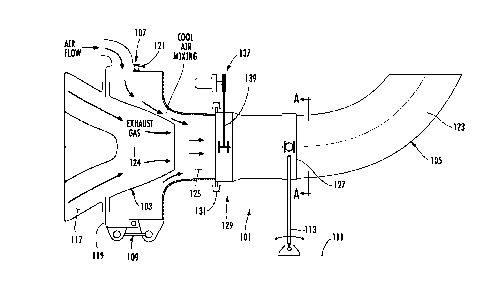Some of the information on this Web page has been provided by external sources. The Government of Canada is not responsible for the accuracy, reliability or currency of the information supplied by external sources. Users wishing to rely upon this information should consult directly with the source of the information. Content provided by external sources is not subject to official languages, privacy and accessibility requirements.
Any discrepancies in the text and image of the Claims and Abstract are due to differing posting times. Text of the Claims and Abstract are posted:
| (12) Patent: | (11) CA 2652685 |
|---|---|
| (54) English Title: | ENGINE EXHAUST SYSTEM WITH DIRECTIONAL NOZZLE |
| (54) French Title: | SYSTEME D'ECHAPPEMENT DE MOTEUR AVEC BUSE DIRECTIONNELLE |
| Status: | Granted and Issued |
| (51) International Patent Classification (IPC): |
|
|---|---|
| (72) Inventors : |
|
| (73) Owners : |
|
| (71) Applicants : |
|
| (74) Agent: | HILL & SCHUMACHER |
| (74) Associate agent: | |
| (45) Issued: | 2012-12-18 |
| (86) PCT Filing Date: | 2007-06-11 |
| (87) Open to Public Inspection: | 2008-10-23 |
| Examination requested: | 2009-04-21 |
| Availability of licence: | N/A |
| Dedicated to the Public: | N/A |
| (25) Language of filing: | English |
| Patent Cooperation Treaty (PCT): | Yes |
|---|---|
| (86) PCT Filing Number: | PCT/US2007/013675 |
| (87) International Publication Number: | WO 2008127260 |
| (85) National Entry: | 2008-11-17 |
| (30) Application Priority Data: | ||||||
|---|---|---|---|---|---|---|
|
An exhaust system for an aircraft has a primary exhaust duct for communicating exhaust gas from an engine exhaust exit and is configured for movement with the engine. A secondary exhaust duct is in fluid communication with the primary exhaust duct and is movably mounted to the airframe. The secondary duct has a portion selectively rotatable relative to the remainder of the secondary duct for directing the exhaust gas vector. The system has means for maintaining a generally consistent relative alignment between the primary duct and the secondary duct.
La présente invention concerne un système d'échappement pour un aéronef comprenant une conduite d'échappement primaire pour communiquer le gaz d'échappement à partir d'une sortie d'échappement moteur et configurée pour le mouvement avec le moteur. Une conduite d'échappement secondaire est en communication fluidique avec la conduite d'échappement primaire et est fixée de façon mobile à la structure de la cellule. La conduite secondaire comprend une partie pouvant tourner de façon sélective par rapport au reste de la conduite secondaire pour diriger un vecteur de gaz d'échappement. Le système comprend un moyen pour maintenir un alignement relatif généralement uniforme entre la conduite primaire et la conduite secondaire.
Note: Claims are shown in the official language in which they were submitted.
Note: Descriptions are shown in the official language in which they were submitted.

2024-08-01:As part of the Next Generation Patents (NGP) transition, the Canadian Patents Database (CPD) now contains a more detailed Event History, which replicates the Event Log of our new back-office solution.
Please note that "Inactive:" events refers to events no longer in use in our new back-office solution.
For a clearer understanding of the status of the application/patent presented on this page, the site Disclaimer , as well as the definitions for Patent , Event History , Maintenance Fee and Payment History should be consulted.
| Description | Date |
|---|---|
| Inactive: COVID 19 - Deadline extended | 2020-05-28 |
| Common Representative Appointed | 2019-10-30 |
| Common Representative Appointed | 2019-10-30 |
| Grant by Issuance | 2012-12-18 |
| Inactive: Cover page published | 2012-12-17 |
| Inactive: Final fee received | 2012-10-03 |
| Pre-grant | 2012-10-03 |
| Notice of Allowance is Issued | 2012-05-03 |
| Letter Sent | 2012-05-03 |
| Notice of Allowance is Issued | 2012-05-03 |
| Inactive: Approved for allowance (AFA) | 2012-05-01 |
| Amendment Received - Voluntary Amendment | 2012-01-11 |
| Inactive: S.30(2) Rules - Examiner requisition | 2011-09-13 |
| Inactive: IPC deactivated | 2011-07-29 |
| Inactive: IPC from MCD | 2010-02-01 |
| Inactive: IPC expired | 2010-01-01 |
| Letter Sent | 2009-06-01 |
| Letter Sent | 2009-05-04 |
| Inactive: Office letter | 2009-05-04 |
| Request for Examination Requirements Determined Compliant | 2009-04-21 |
| All Requirements for Examination Determined Compliant | 2009-04-21 |
| Request for Examination Received | 2009-04-21 |
| Inactive: Single transfer | 2009-03-20 |
| Inactive: First IPC assigned | 2009-03-12 |
| Inactive: First IPC assigned | 2009-03-12 |
| Inactive: IPC assigned | 2009-03-12 |
| Inactive: First IPC assigned | 2009-03-12 |
| Inactive: IPC assigned | 2009-03-12 |
| Inactive: Cover page published | 2009-03-11 |
| Inactive: Notice - National entry - No RFE | 2009-03-06 |
| Inactive: First IPC assigned | 2009-03-04 |
| Application Received - PCT | 2009-03-03 |
| National Entry Requirements Determined Compliant | 2008-11-17 |
| Application Published (Open to Public Inspection) | 2008-10-23 |
There is no abandonment history.
The last payment was received on 2012-05-17
Note : If the full payment has not been received on or before the date indicated, a further fee may be required which may be one of the following
Please refer to the CIPO Patent Fees web page to see all current fee amounts.
Note: Records showing the ownership history in alphabetical order.
| Current Owners on Record |
|---|
| BELL HELICOPTER TEXTRON INC. |
| Past Owners on Record |
|---|
| CHARLES HOLLIMON |
| JOHN BARBER |
| JOHN SHERRER |
| ROBERT LARAMEE |